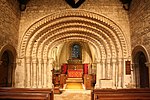East Wood, Great Casterton
Sites of Special Scientific Interest in Rutland

East Wood is a 6.6-hectare (16-acre) biological Site of Special Scientific Interest north of Great Casterton in Rutland.This semi-natural wood is on boulder clay of glacial origin. The dominant trees are ash, oak and wych elm, with a few wild service trees and small leaved limes. In well-drained areas there is a diverse ground flora typical of ancient woodland, and in the less well-drained parts, tufted hair-grass predominates.
Excerpt from the Wikipedia article East Wood, Great Casterton (License: CC BY-SA 3.0, Authors, Images).East Wood, Great Casterton
Pickworth Road,
Geographical coordinates (GPS) Address Nearby Places Show on map
Geographical coordinates (GPS)
| Latitude | Longitude |
|---|---|
| N 52.693 ° | E -0.516 ° |
Address
Pickworth Road
Pickworth Road
PE9 4DR , Great Casterton
England, United Kingdom
Open on Google Maps









